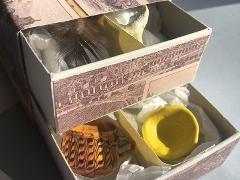Mini-museum
Create your own mini-museum or cabinet of curiosities!

How about making a mini-museum at home? The very first museums were just that - private collections put together by wealthy men who showed them to visiting friends. You can fill yours with things important to you and share it with your family at home - and with us online!
These first private museums were called 'cabinets of curiosity' or 'cabinets of wonder'. They were normally wooden cupboards, with lots of drawers, or sometimes even whole rooms. They were full of unusual or important objects from around the world and first appeared in the 1500s. Only wealthy people (men) had enough money to buy the objects to put in them. The collection of Sir Hans Sloane (1660 - 1753) became the start of the British Museum - so who knows what might happen to yours!
The cabinets sometimes grouped the objects into seven areas:
- natural history - e.g. shells, claws, feathers and teeth
- geology - e.g. stones and minerals
- ethnography - objects from other countries representing the people that lived there, their customs, habits and mutual differences.
- archaeology - Greek and Roman objects like lamps
- religious or historical relics - e.g. carved beads and objects from royalty
- works of art - e.g. miniature portraits, sculptures and paintings
Sometimes the collectors thought they had bought the most fantastical things: a 'dragon's egg', a 'unicorn horn' (actually from a narwhal - a type of whale) or 'a mermaid's hand'!
Make your own 'cabinet of curiosity'
1. Find a suitable container- remember the size of it will affect what you can put in it. Do you have an old shoe box? Or maybe a cardboard box a delivery has come in? Make sure you have wiped it clean.
2. Decide what kind of objects you want to put in it. Will you come up with your own seven areas like the traditional cabinets of curiosity so your cabinet is a real mix of things? Perhaps choose things that are really precious to you or the most unusual things you can find. Or maybe you could have one big theme e.g. your family, your last holiday. Take a look at home and when you are out on your daily exercise. Here' some more ideas of thing you could include:
- your life: draw a self-portrait (find a template frame online that you can draw in); a lock of your hair; a piece of jewellery; a programme or ticket from an event you went to e.g. a football match or your school play
- your local area: draw a picture of your street/school/youth club etc; a wildflower that you spot on your daily exercise (make sure it's not a protected one you shouldn't pick); an advert for a local shop; a map of the area (just the small part where you live)
- holidays:a coin from a different country; a postcard; a shell; a souvenir; do a drawing of an animal or a special building you saw
3. You might want to decorate the outside of your box - you could cover it in wrapping paper or if it has a plain surface with coloured pencils and pens. Some of the original cabinets of curiosity were beautifully decorated wooden cupboards made from different woods and with lots of carving.
4. If you are using one large box divide it down into smaller compartments like the drawers the cabinets had. Cut a strip of card a bit longer than your box. Bend the strip at both ends so it fits into your box. You might want to glue the folded ends onto the inside of the box. To divide the box width ways cut another strip and do the same. This time you will need to cut a slit in the strip so it can fit over the first strip you have fitted. You might want to put some padding underneath some of the objects to keep them safe. Try tissue paper or cotton wool.
5. Now place your objects in your 'cabinet'. You can keep adding to it as you find things just as the original collectors did.
6. If you want your cabinet to be a bit more like a museum you might want to add a label (a name) for each item. Sir John Sloane catalogued (made individual records) for his collection just as museums do today. The owners of the original cabinets of curiosity enjoyed showing them to their friends so perhaps you'd like to show it to your family.




